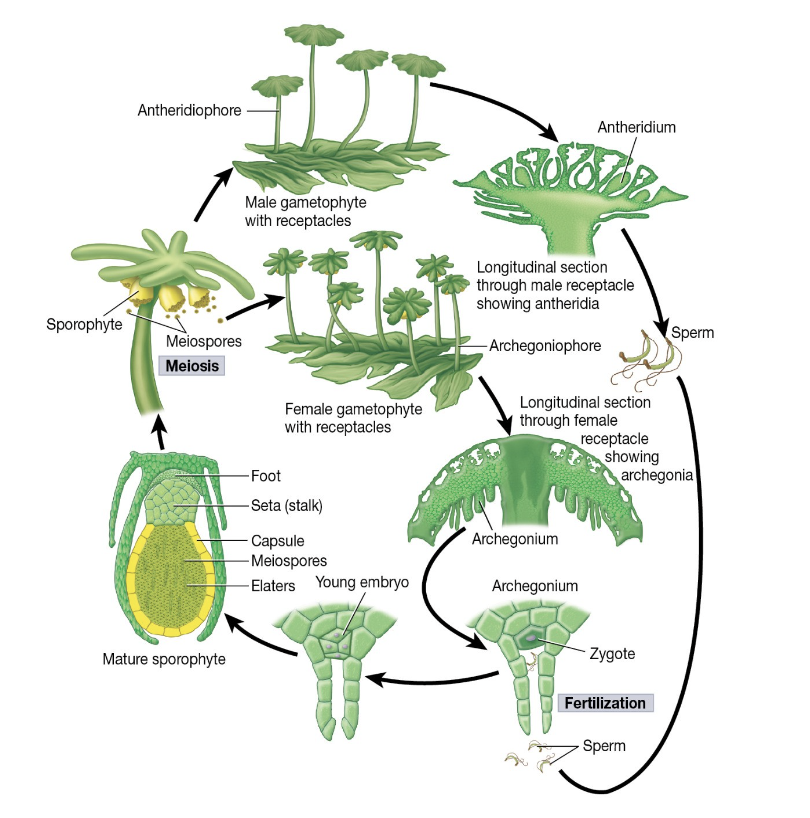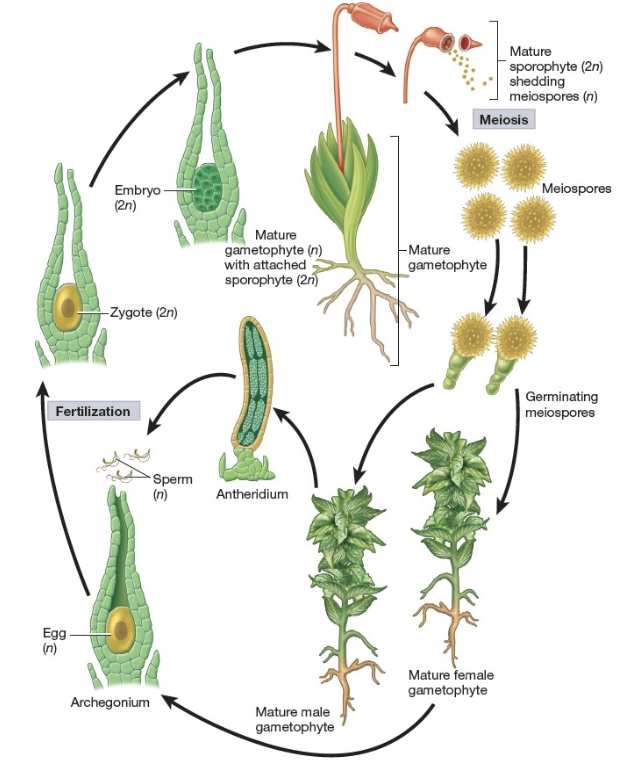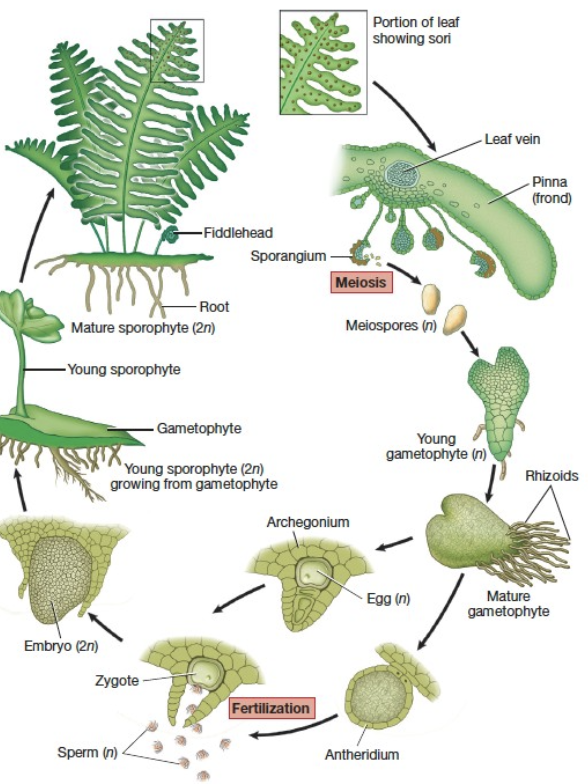Bryophytes and Seedless Vascular Plants
Ploidy: the number of sets of chromosomes in an organism
Diploid: two sets of chromosomes, 2n
Haploid: one set of chromosomes, n
Gametophyte: the haploid form of an organism which gives rise to the male and female gametes
Sporophyte: the diploid form of an organism which gives rise to haploid spores
Alternation of Generations
The sporophyte undergoes meiosis forming haploid spores
Those haploid spores undergo mitosis to become haploid gametophytes
Those gametophytes undergo mitosis again to form the haploid gamete
Those gametes combine during fertilization to form a diploid zygote
The diploid zygote grows into a new sporophyte and the process repeats
Bryophytes
Bryophyte: non vascular plants
Three phyla of bryophytes:
Hepatophyta - liverworts
Bryophyta - mosses
Anthocerophyta - hornwarts
Nonvascular plants lack specialized conducting tissues to transport water and nutrients through the plants body
They lack “true” roots, stems, and leaves
They only produce one type of spore
Phylum Hepatophyta:
Liverworts
Produce both asexually and sexually
Asexually via gemmae and gemma cups, sexually via gametophores producing gametes
Key anatomical features:
Thallus: the body of a liverwort
Rhizoids: hairlike structures that anchor the thallus
Two distinct types:
Thalloid Liverworts
Possess thalli: flat, leaflike lobed bodies
Commonly found along creek banks or in moist soil
Leafy Liverworts
Resemble mosses
Commonly found on tree barks in tropical and subtropical environments
Liverwort Lifecycle

Phylum Bryophyta:
Also called the true mosses
Found in temperate zones growing on trees, rocks, and the sides of buildings
Serves as a pioneer species to help form soil
Key anatomical features:
Operculum: lid-like structure on the tip of the capsula
Peristome: teeth like structures that lock the operculum to the capsule
Protonema: developed from immature spores and will eventually develop into the “leafy” gametophyte
Moss Lifecycle

Vascular Plants
Possess tissues for conducting water and nutrients throughout the plant
Xylem: conducts water and dissolved minerals
Phloem: conducts nutrients, hormones, and other molecules
Vascular plants possess true roots, stems, and leaves
Separated into seedless vascular plants and seed plants
Phylum Lycophyta:
Club mosses, quillworts, and spike mosses
Homosporous — only produce one type of spore
Key anatomical features:
Rhizome: produces aerial stems and underground roots
Sporophyllus: reproductive sporangia located on the surface of leaves
Strobilus: cone-shaped structure that contains spores
Phylum Psilotophyta:
Known as whisk ferns
Homosporous — only produce one type of spore
Does not have leaves or roots
Has a photosynthetic stem that contains bright yellow synangia
Horizontal rhizome gives rise to the aerial stem
Phylum Sphenophyta:
Known as horsetails
The aerial stems of horsetails are ribbed, and stomata occur in the grooves between the ribs
Rhizomes run horizontally across ground and gives rise to aerial stem and roots
Key Anatomical structures:
Microphylls: small, scalelike leaves arranged in a whorl at the nodes
Pith: the center of the stem, hollow in horsetails
Sporangiophores: make up the strobili at the tip of the stem, contains sporangia that produce spores
Phylum Pterophyta:
Also known as ferns
Key anatomical features:
Fronds: the leaves of ferns, arise from rhizomes
Fiddlehead: tightly rolled up and coiled structure consisting of immature fronds
Pinnae: ornate leaflets possessed by compound frond ferns
Petiole: attaches the pinnae to the rhizome, sometimes called stalk
Sori: the sporangia of ferns that appear as distinct brown spots on the underside of the frond
Indusium: colorless flap that protects the sori
Annulus: fuzzy region of the sorus that catapults mature spores
Fern Life Cycle:
